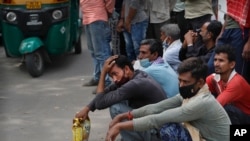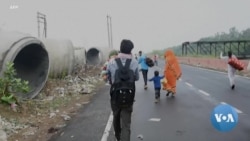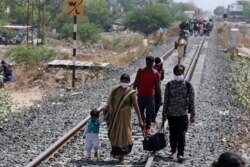Clutching their scant possessions, millions of migrants stranded in India’s vast cities trekked hundreds of kilometers to the refuge of their village homes last year after the government ordered a strict lockdown starting March 25 to stave off the COVID-19 pandemic.
All transportation had halted and cities where they had found work as drivers, security guards and construction labor, among other things, had abruptly shuttered, snatching away their meager livelihoods.
India’s more than two month-long shutdown -- one of the world’s strictest -- led to a mass exodus of migrant workers who sustain the big city economy. Most walked, some with children in tow. Some cycled along deserted highways while others crammed into what few buses operated to take them home as the scale of the humanitarian crisis unfolded.
Back in their villages, life was not easy either. Kamal Singh, who used to drive a cab in New Delhi, recalled how he and three others used to go to a small hill near their home in the northern Rajasthan state before the pandemic to break stones to sell to a handful of people who had received a government grant to build homes.
“It was summer and used to get very hot in the day,” recalled Singh, whose village lies close to a hot, desert region. “We could only work early in the morning and evening. But somehow we managed to fill one tractor trolley to earn about $10 dollars between four people.” It just about sufficed to buy food for his family – parents, wife and two sons.
India’s vast unorganized sector supports more than 90% of livelihoods in the country. Many of them are rural migrants, who come to work in populous cities like New Delhi and Mumbai.
“That is why it is only in India out of the major economies that you saw mass migration from urban to rural areas,” said Arun Kumar, a former professor of economics at Jawaharlal Nehru University. “You did not see it in the U.S. or in UK or in China because they don’t have such a large unorganized sector. Also, nowhere does the unorganized sector have the kind of poverty that is there in India. That is why India was particularly hard hit.”
The government said more than 11 million migrants went from cities to their homes during the lockdown.
Struggle continues
A year on, India’s cities are up and running and many migrants have returned to search for livelihoods. While some have found jobs, others are struggling in cities where the pandemic has changed old patterns.
Singh returned last month to resume operating his cab, which he bought two and a half years ago after raising a $6,000 loan. It used to fetch a good income but the new norm of working from home has left him with few customers. That is no surprise – the streets in the business hub of Gurugram near Delhi, once crammed with cars and cabs, are largely deserted. “I hardly got any rides and could barely cover my expenses on the cab,” he said.
Unable to repay the monthly instalments on his loan, a dejected Singh finally sold the cab this month. He now has a temporary job as a driver.
Economy suffers
The economic crisis triggered by the pandemic sparked India’s worst recession in decades. The country also witnessed the steepest decline among the world’s major economies. While the overall economy is expected to shrink by nearly 8% in the last year, the fall was much steeper during the strict lockdown from April to June when it plummeted by about 24%.
It brought more hardship than war says Kumar, who has authored a book, “Indian Economy’s Greatest Crisis.”
“What happens in war is that everybody is busy fighting the war, producing for the war etc. But here because people are not working, huge unemployment is there. And that is why the economy dropped very sharply.”
Jobs are returning slowly as the economy revives – India posted modest growth from October to December and according to a recent economic survey the recovery is expected to gather pace in the coming year.
Twenty-six-year-old Arun Yadav, who lost his job at a food counter at the New Delhi airport during the lockdown, was hired at another counter two months ago. In his village in Uttar Pradesh, where he relocated after losing his job, times were tough.
“I tried to do something that would yield an income and help the family but I could do nothing due to the lockdown. It was very hard,” recalled Yadav. “Now everything is good. I have even returned the loans I took during the lockdown.”
But the pandemic has left its scars on migrants worried whether cities will afford them the same opportunity as in pre-pandemic times. Kumar said recent estimates suggest that some 20% of those who lost jobs during the pandemic are still searching for employment.
And as India, which has counted the world’s third highest number of COVID-19 infections, grapples with a second wave in some parts of the country, concerns are again running high about what the future holds, especially as its most industrialized state, Maharashtra, is the epicenter of the fresh outbreak.
Economists warn that although Indian cities have largely resumed normal activity, another outbreak will set back hopes of a swift recovery.
Those who have already suffered know all too well what that means.
“There is always fear in my heart that suppose another such problem comes, how will we manage specially if our family increases,” said Yadav, who got married two years ago.
It’s a question that will linger with these migrants for long.












